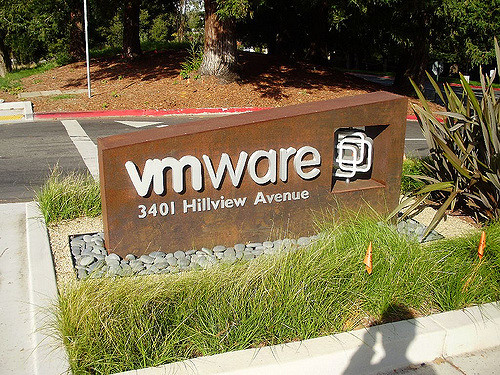What Is Next For VMWare?

According to a Gartner report, VMWare (NYSE:VMW) accounts for 91% share of the virtualization infrastructure software market. Even after including vendors like Microsoft that provide virtual machine capabilities bundled with their other server offerings, VMWare still leads with about 60%-75% share of the market.
VMWare’s Financials
VMware’s fourth quarter revenues grew 16% over the year to $2.58 billion versus the Street estimate of $2.5 billion. Non-GAAP earnings were $1.98 per share, ahead of the Street’s forecast of $1.88. Net income for the quarter came in at $1.21 per share compared with a loss of $0.96 per share reported a year ago.
By segment, license revenues grew 21% over the year to $1.23 billion and services segment grew 13% to $1.36 billion for the quarter. Hybrid Cloud and SaaS accounted for 10% of total revenues and grew 35% over the year.
For the current year, VMware expects revenues of $10.03 billion with license revenues expected to grow 12.8% to $4.28 billion. It projected non-GAAP earnings of $6.49 per share. VMWare expects to end the current quarter with revenues of $2.25 billion and non-GAAP income of $1.27 per share. The market was looking for revenues of $10.04 billion and an EPS of $6.52 for the year and revenues of $2.24 billion and an EPS of $1.28 for the first quarter.
VMWare’s Market Expansion
Earlier this quarter, VMWare announced the biggest release of its NSX offering. VMware NSX is its network virtualization and security platform that offers logical network pieces to connect workloads on virtual machines. Till recently, NSX supported vSphere, VMWare’s original platform. The latest release decouples NSX from vSphere and works on other clouds including AWS, Microsoft Azure, and IBM Cloud. The move will help VMWare compete more strongly with Cisco. Known as NSX-T, the new offering will become its primary platform going forward to provide a unified network architecture for on-premises data center, enterprise branches, Internet of Things, and multiple public cloud providers.
VMWare is also working on enhancing its security capabilities. It recently announced the release of the VMware Service-defined Firewall. The latest offering is an innovative approach to internal firewalling that claims to reduce the attack surface for on-premises and cloud environments. It leverages VMWare’s other offerings such as NSX and AppDefense to gain deeper understanding and insight into the application and its microservices over time. It uses machine intelligence from millions of VMs globally to build an accurate view of the ideal state of the application. Once the ideal state has been defined, it generates adaptive security policies for the Service-defined Firewall solution. It can detect and block malicious traffic on the network and can stop any malicious behavior within the OS or application at run time.
One of the biggest advantages of VMWare’s firewall is its cloud-focused architecture. Unlike traditional firewalls that require “hairpinning” traffic out of the virtual environment and into a hardware appliance for scanning, this solution is built for the cloud and can run wherever the application runs across clouds. This not only ensures scalability, but also results in consistency of security rules. Through this release, VMWare is focusing on making security intrinsic to the infrastructure so it can significantly reduce the risk to critical applications, sensitive data, and users.
Besides product upgrades, VMWare has also been growing inorganically. Earlier last month, it announced the acquisition of its technology partner AetherPal. Founded in 2009, New Jersey based AetherPal offers an IP-connected smart remote control for mobile operators and enterprises. AetherPal’s remote control tool supports Android, Windows CE, and Windows Mobile devices to allow IT teams, to remotely troubleshoot problems. Since May 2017, VMware was reselling AetherPal’s Remote Support solution as an add-on to VMware Workspace ONE. The acquisition will help VMware fully integrate remote support capabilities into the Workspace ONE platform and to provide full lifecycle support for digital transformations for its customers. Prior to the acquisition, AetherPal had raised $6 million at undisclosed valuations in funding from investors including New Venture Partners and PJC. According to Owler, the company was operating with annual revenues of $21.4 million. Terms of the acquisition were not disclosed.
According to analysts, the server virtualization market is saturated. As part of its market expansion strategy, VMWare continues to diversify from server racks into cloud computing opportunities. The NSX, for instance, will help it capture network virtualization customers. Similarly, the Firewall will help it gain security customers. Analysts believe that VMware will continue to get deeper into customers’ networks via products geared toward the hyperconverged infrastructure, hybrid cloud virtualization, and containerization. What other capabilities do you think it needs to add to meet this objective? What smaller companies do you think VMWare can acquire to help meet this goal?
VMWare needs to make some significant adjustments to its product strategy to compensate for the saturation in the server market. Companies have great difficulty to take such shifts in stride. It remains to be seen whether the recent acquisitions and product diversifications would suffice.
Its stock is trading at $173.37 with a market capitalization of $71 billion. It touched a 52-week high of $183.41 earlier last month soon after result announcement. It was trading at a 52-week low of $117.61 nearly a year ago.
Photo Credit: sporst/Flickr.com.



